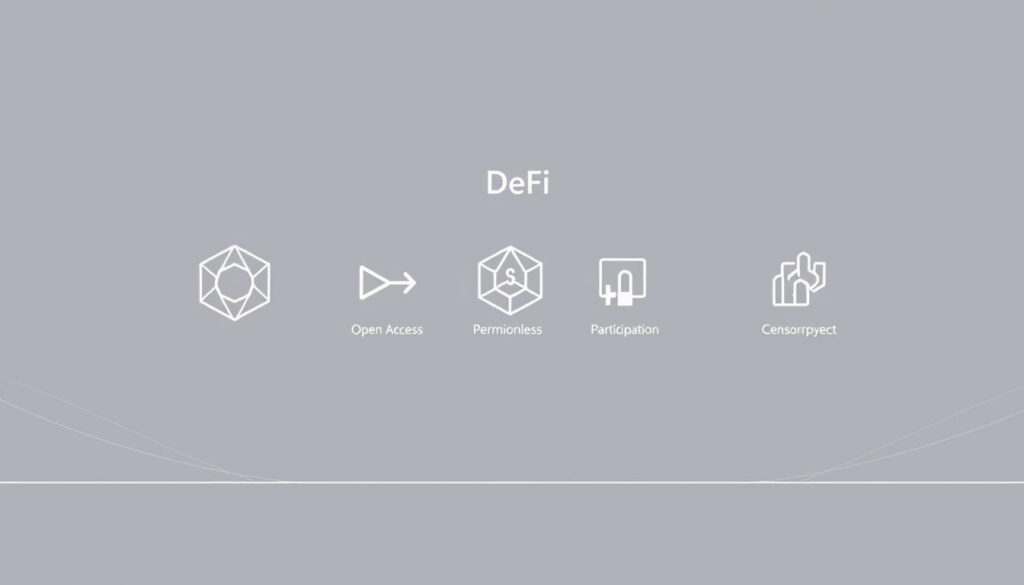The financial world is undergoing a radical transformation. New systems powered by blockchain are creating global access to banking services without middlemen. Recent data shows this sector grew to $13.6 billion in 2022, with experts predicting 46% annual growth through 2030.
These systems use smart contracts – self-executing code on networks like Ethereum – to handle everything from loans to insurance. This approach removes geographic barriers while ensuring transparent, secure transactions. Over 5 million people now use these platforms monthly, proving their real-world impact.
Developers face unique challenges in this space. Security vulnerabilities and regulatory uncertainty require careful planning. However, the rewards include creating services that empower underserved communities and reshape economic participation.
This resource breaks down essential components for building robust financial solutions on distributed ledgers. You’ll learn how peer-to-peer models differ from traditional banking and discover strategies for creating user-friendly platforms. We analyze current trends and provide frameworks for navigating technical complexities.
Key Takeaways
- Global blockchain-based financial systems grew 46% annually since 2022
- Smart contracts enable automated, trustless transactions
- Over 5 million active monthly users demonstrate market traction
- Security and compliance remain critical development priorities
- Successful platforms prioritize accessibility and transparency
Overview of the DeFi Revolution and Protocol Development
A silent revolution is reshaping how people access financial tools worldwide. Traditional systems built around banks struggle with slow transfers, expensive fees, and limited availability. Over 1.7 billion adults lack basic banking access, while others face hurdles like credit checks and geographic restrictions.
Breaking Free From Legacy Systems
Blockchain networks introduced a game-changing alternative. Unlike conventional services requiring bank approvals, these systems let users trade assets or borrow funds directly through code. Ethereum’s 2017 upgrade enabled self-executing agreements, sparking innovations like automated lending pools by 2019.
Three factors fuel this transformation:
- Cost reduction: Peer-to-peer models slash fees by 60-80% compared to wire transfers
- Access expansion: Anyone with internet can use services, bypassing paperwork
- Speed improvements: Transactions settle in minutes instead of days
What’s Driving Adoption?
Users increasingly seek control over their assets. Over 80% of crypto holders under 35 prefer managing funds without institutions. Markets respond – decentralized exchanges now handle $50 billion monthly volume. Developers build solutions addressing real needs: instant loans, yield farming, and borderless payments.
The sector’s value surged from $700 million in 2020 to $13.6 billion by 2022. This growth stems from transparent operations and 24/7 availability. As trust in traditional systems erodes, blockchain-based alternatives gain momentum across demographics.
Fundamentals of Blockchain Technology in DeFi
Modern financial innovations rely on three core technical pillars: distributed networks, verifiable records, and unbreakable security. These elements form the backbone of systems enabling peer-to-peer value exchange without centralized control. This evolving financial landscape depends on blockchain’s unique architecture to maintain trust among participants.

Decentralization, Transparency, and Immutability
Blockchain networks operate through thousands of nodes working in unison. Each node stores identical transaction records, creating redundancy that prevents data loss. This structure ensures no single entity can alter transaction histories or freeze accounts.
Every action on-chain becomes permanently visible to all participants. Users verify transactions through public addresses while maintaining personal privacy. This balance of openness and confidentiality builds accountability without compromising sensitive information.
Once recorded, transactions become irreversible. Network participants must approve changes through majority consensus, making unauthorized alterations practically impossible. This permanence protects users from fraud and ensures reliable audit trails.
Cryptography and Consensus: Guardians of Trust
Advanced encryption shields user activities through mathematical puzzles only valid participants can solve. Private keys act as unforgeable digital signatures, while public keys enable secure interactions between strangers. These mechanisms prevent unauthorized access to funds or data.
Networks maintain agreement through predefined rules called consensus mechanisms. Popular methods like Proof of Work and Proof of Stake validate transactions through economic incentives rather than third-party oversight. This approach keeps systems operational 24/7 while preventing double-spending attacks.
Together, these technologies create environments where strangers can transact confidently. They enable financial tools that operate predictably across borders, serving users excluded from traditional banking channels.
Core Principles of Decentralized Finance
Blockchain-based financial systems thrive on foundational rules that break traditional barriers. These rules focus on universal access and collaborative innovation, creating tools anyone can use or improve. Over 80% of new projects now prioritize these standards to build trust and expand their reach.

Openness and Interoperability
Public code repositories form the backbone of these systems. Developers share their work openly, letting others verify security and suggest improvements. This approach led to 40% faster bug detection compared to closed systems last year.
Cross-chain bridges now connect over 15 major networks, enabling asset transfers between ecosystems. Users can trade tokens from different chains without centralized exchanges. This fluid movement boosts liquidity and creates new opportunities for yield generation.
Three critical advantages emerge:
- Transparent operations: Anyone can audit transaction logic
- Shared infrastructure: Builders reuse proven components
- Borderless access: Services work globally by default
Modern platforms eliminate gatekeepers through self-service designs. A farmer in Kenya can borrow against crypto assets as easily as a trader in New York. This aligns with findings from our complete DeFi guide, showing 63% of users value equal access above all else.
Collaboration drives progress. When one team creates a lending tool, others integrate it into insurance products or prediction markets. This composability turns basic services into complex financial instruments accessible through simple interfaces.
Smart Contracts: The Building Blocks of DeFi
Digital agreements are reshaping how people exchange value in modern systems. These coded contracts execute automatically when conditions are met, cutting out middlemen while maintaining ironclad rules. Over $2 trillion in assets now flow through these systems annually, proving their reliability at scale.

Automation and Trust in Financial Transactions
Self-operating agreements handle tasks that once required banks or lawyers. Loan approvals now happen in minutes instead of days. Users see every rule written in code they can verify before interacting.
Four pillars make these tools revolutionary:
- 24/7 Operation: No business hours or holidays
- Cost Slashing: Removes 80% of traditional fees
- Error Reduction: Code executes precisely as written
- Global Access: Works identically in Nairobi or New York
| Feature | Traditional Contracts | Smart Contracts | User Benefit |
|---|---|---|---|
| Execution Speed | 3-7 days | 3-7 minutes | Faster access to funds |
| Cost per $1k | $25-$150 | $0.50-$5 | Higher returns |
| Audit Trail | Paper records | Blockchain history | Transparent tracking |
| Failure Points | 12+ touchpoints | Single codebase | Reduced errors |
Builders create complex tools by stacking these agreements like digital bricks. A lending tool can connect to insurance systems automatically. This “money Lego” approach lets developers assemble new services rapidly.
Security remains critical – a single coding error could cost millions. Teams now spend 30% of project timelines on audits and tests. Understanding these potential risks helps create safer systems that protect user assets while delivering innovation.
decentralized finance protocol development guide

Creating innovative financial tools on blockchain networks demands careful planning and execution. Successful projects begin by identifying gaps in existing systems – whether high fees, slow transactions, or limited accessibility. Market analysis reveals Ethereum hosts 65% of active platforms, while newer chains like Solana attract developers with sub-second settlement times.
Architecture decisions make or break platforms. Modular designs allow components to evolve independently, while cross-chain bridges enable asset transfers between networks. Consider these critical factors when designing systems:
| Feature | Traditional Approach | Modern Solution | Impact |
|---|---|---|---|
| Transaction Speed | Hours/Days | Seconds | Better UX |
| Fee Structure | Fixed Rates | Dynamic Pricing | Fairer Costs |
| Security Audits | Annual Checks | Continuous Monitoring | Risk Reduction |
| Governance | Centralized Teams | Community Voting | Increased Trust |
Smart contract safety remains paramount. Leading teams allocate 40% of budgets to code audits and bug bounties. Multi-signature wallets and circuit breakers add protection layers during unexpected events.
Community engagement drives adoption. Transparent roadmaps and governance tokens let users shape platform futures. Platforms with active forums see 3x longer user retention than closed systems.
Ongoing adaptation separates leaders from obsolete projects. Regular upgrades addressing gas fees and scalability keep platforms competitive. Integrations with prediction markets and NFT collateralization create new use cases beyond basic trading.
Stepwise Process for Developing a Robust DeFi Platform
Building next-gen financial systems requires methodical planning and user-focused design. Teams must balance technical innovation with real-world needs to create tools people trust and use daily.
Pinpointing Real Needs
Successful projects start by identifying friction points in current systems. Analyze where traditional models fail – high fees, slow processing, or exclusionary practices. Research shows 68% of adopters prioritize platforms solving specific pain points over generic solutions.
Technical Blueprinting
Choosing the right blockchain foundation impacts scalability and security. Evaluate transaction speeds, tool availability, and community support. Leading teams prototype core features early, testing concepts with target users before full-scale development.
Phased launches reduce risks. Start with core functionality, then add layers like governance tools or cross-chain compatibility. Continuous security audits and community feedback loops keep platforms adaptable as markets evolve.
The future lies in systems merging technical robustness with intuitive access. By focusing on genuine problems and scalable solutions, builders create lasting value in this dynamic landscape.


No comments yet